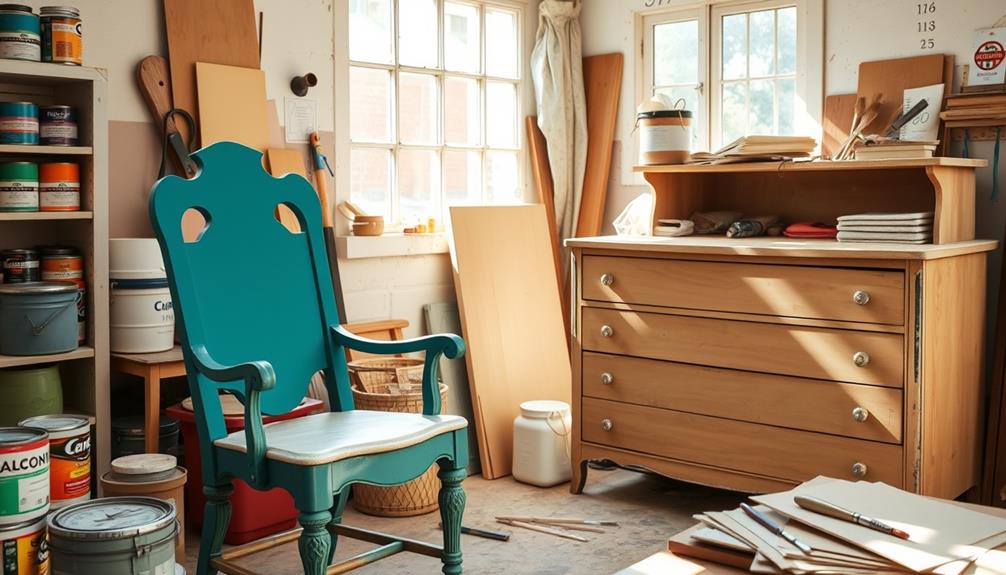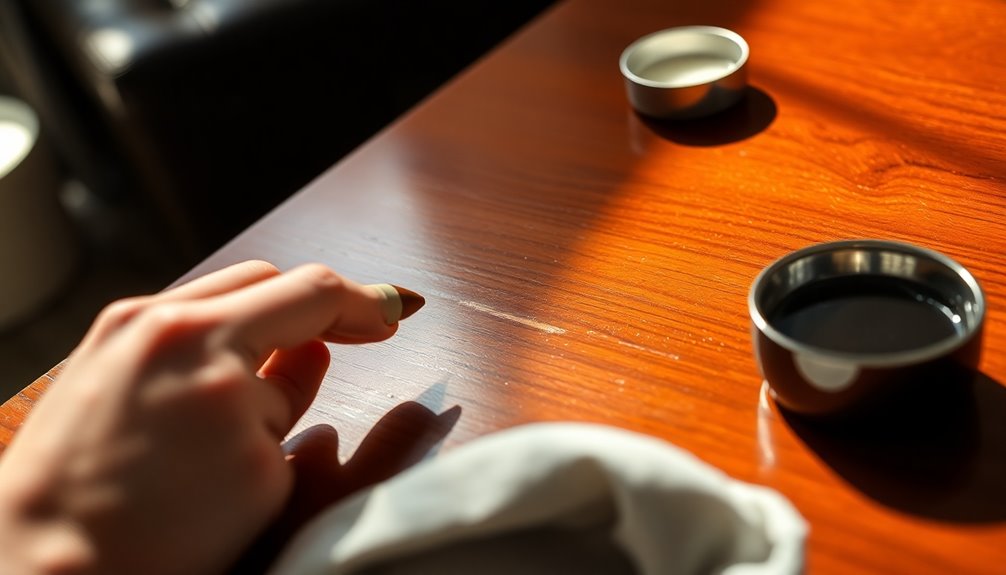To renovate furniture, begin by assessing its condition. Examine for any structural damage and surface flaws, and confirm that the hardware is in good condition. Then, remove old finishes by using chemical strippers or heat guns, while ensuring you are wearing protective gear. After cleaning the surface, sand it with coarse and fine grit sandpaper, making sure to remove any dust before proceeding. Select your desired finish—oil-based for a warmer look or water-based for a quicker drying time—and apply it using a brush or rag. Seal the finish with polyurethane for added durability. Each step in the process builds upon the previous one, expanding the possibilities for your piece as you experiment with various techniques and tips.
Key Takeaways
- Inspect furniture for structural damage and surface imperfections before starting the refurbishing process.
- Use effective stripping methods, such as chemical strippers or heat guns, to remove old finishes safely.
- Sand the surface using coarse grit sandpaper for removal, then fine grit for smoothing, ensuring a clean and dry surface.
- Apply chosen finishes, like oil-based or water-based products, using a brush or rag, and seal with polyurethane for durability.
- Document repairs and enhancements to maintain the furniture's emotional connection and legacy while increasing its aesthetic appeal.
Importance of Furniture Refinishing
When you consider the importance of furniture refinishing, think about how it helps preserve not just the piece itself but also the stories and memories tied to it. Each refinished item can become a canvas of emotional connections, representing cherished moments and family legacies.
Quality refinishing not only enhances the aesthetic appeal of vintage pieces but also greatly increases their value over time. Incorporating techniques that celebrate modern farmhouse decor trends allows for a seamless blend of old and new, creating a timeless look that's both inviting and stylish.
Using proper refinishing techniques guarantees that the furniture remains in excellent condition, preventing damage and prolonging its life. This commitment to sustainability aligns with a growing appreciation for environmentally friendly practices, promoting a culture of reuse instead of waste.
As you engage in furniture refinishing, you also foster community engagement, connecting with fellow enthusiasts who share knowledge and skills. This collaboration sparks creativity and encourages the development of new techniques.
Tools and Materials Needed
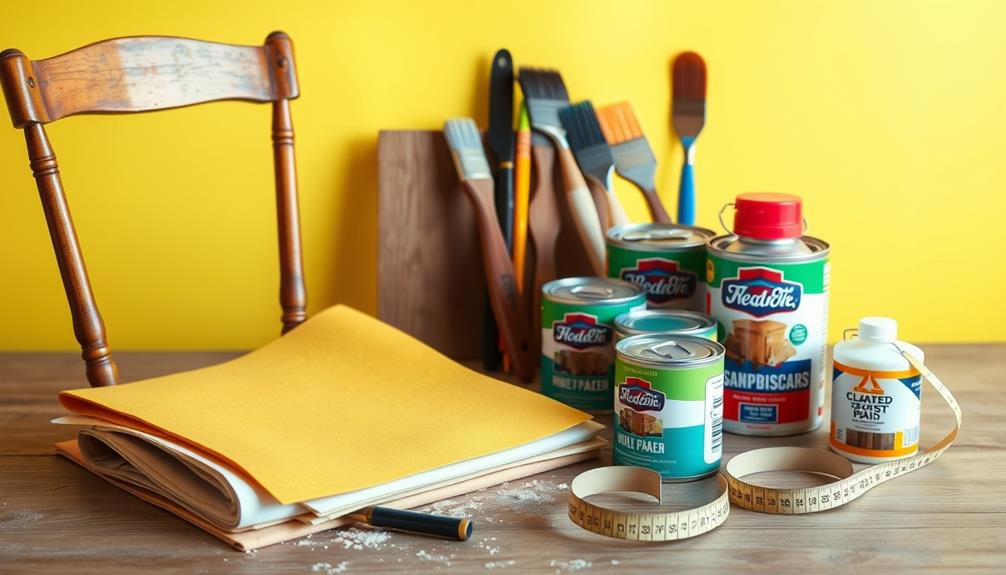
Refurbishing furniture successfully relies on having the right tools and materials at your fingertips. First, you'll need sandpaper or a power sander to smooth out surfaces before applying finishes. A set of quality paintbrushes is vital for achieving an even coat on your refinishing project. Don't forget a putty knife to fill in any gaps and cracks that may need attention.
Additionally, if you're working in a home with pets or allergens, consider using a vacuum with superior dust removal to keep your workspace clean and safe.
Protective gear, like gloves, masks, and goggles, is essential to keep you safe from dust and harmful chemicals during the process. To prepare your furniture for refinishing, gather cleaning materials such as dish soap, warm water, and microfiber cloths to remove dirt and old finishes effectively.
For structural repairs, wood glue is a must-have, while epoxy putty is perfect for filling larger flaws you may encounter. This combination will help you achieve a polished final result.
Assessing Your Furniture Condition
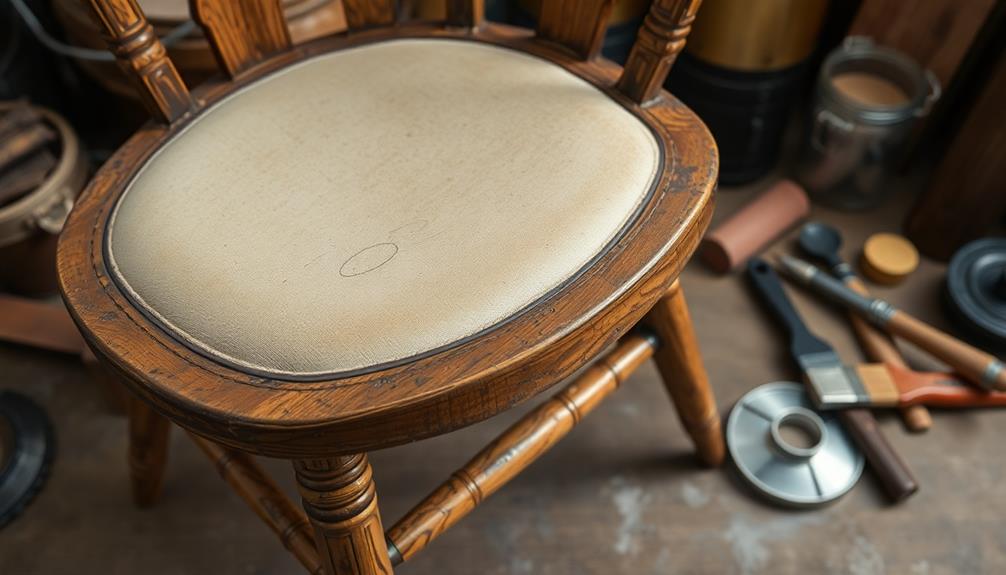
Start by inspecting your furniture for any structural damage, like cracks or loose joints, as these issues can impact your refurbishing efforts.
It's also crucial to reflect on how the condition of the furniture can affect its overall value, especially if you plan to sell it later.
Next, take a close look at the surface for imperfections that might need attention, such as dents or scratches. For instance, if you notice any significant wear, you might want to explore effective natural ingredients for grout cleaning to enhance the overall appearance.
Inspect for Structural Damage
A thorough inspection for structural damage is essential before diving into the refurbishing process.
Start by examining all joints and connections to guarantee they're intact and not loose. This is vital for maintaining structural integrity and the longevity of your furniture.
Next, check for any signs of wood rot, especially in areas where moisture might've accumulated. Wood rot can greatly compromise the piece's stability.
Inspect the legs and support structures for cracks or breaks. If you find any, you might need to perform repairs using wood glue or consider replacing parts to restore strength.
Also, look for signs of pest damage, such as small holes or sawdust, indicating an infestation that needs to be addressed before you proceed with refurbishing.
Identify Surface Imperfections
Once you've guaranteed the structural integrity of your furniture, the next step is to identify surface imperfections that could affect the final look. Carefully inspect all surfaces for visible imperfections like scratches, dents, and stains. These blemishes can greatly impact the overall appearance and finish of your piece.
Use a bright light to reveal small flaws that might be hidden in shadows, ensuring a thorough evaluation. As you inspect, document any major damages or areas requiring repair. This record will help you determine the necessary supplies and techniques needed for refinishing and refurbishing.
Don't forget to reflect on the age of your furniture, as historical significance may influence your approach to repairs. Keeping the furniture's value and integrity in mind can guide your decisions on how far to go with the refinishing process.
If you find deep stains or notable imperfections, prioritize these areas during your refurbishing efforts. By carefully identifying and documenting these surface imperfections, you'll set yourself up for success in restoring your furniture to its former glory.
Evaluate Hardware Condition
When evaluating the condition of your furniture, don't overlook the hardware, as it plays an essential role in both functionality and design.
Start by inspecting each piece of hardware, like hinges, knobs, and pulls, for signs of rust, corrosion, or wear that could affect their functionality and aesthetics. Loose screws or fittings may need tightening or replacement to guarantee your furniture remains sturdy and safe for use.
Next, assess the finish of the hardware. If it looks tarnished or discolored, consider cleaning it with suitable solutions or replacing it if necessary. This can enhance the overall appearance and longevity of your piece.
Also, evaluate the style and material of the hardware to determine if it complements the intended design of your refurbished furniture. The right hardware can elevate your piece and align with your vision.
Stripping Old Finishes
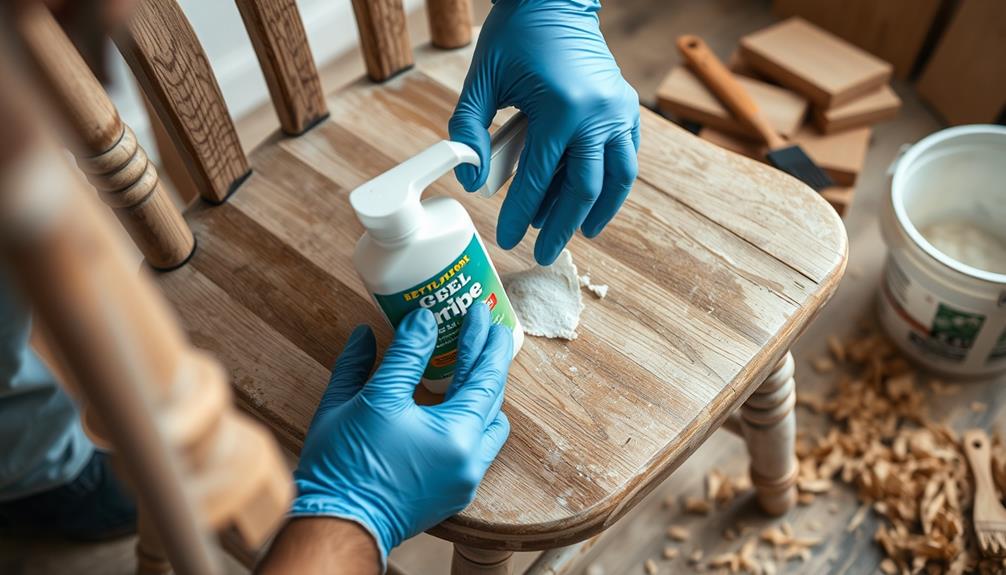
When it comes to stripping old finishes, you've got a couple of effective methods: chemical strippers or heat guns.
Always remember to prioritize safety by working in a well-ventilated area and wearing gloves and protective eyewear.
Once you've removed the old finish, make sure to rinse the surface thoroughly before moving on to sanding or refinishing.
Effective Stripping Methods
Stripping old finishes from furniture can seem intimidating, but with the right methods, you can make the process efficient and effective. Here are three effective stripping methods you can try:
1. Chemical Strippers: Use products like Citristrip. Apply the stripper generously and cover it with plastic wrap to enhance efficacy. Let it sit for at least 30 minutes, or up to 24 hours for tougher finishes.
Always test the stripper on a small, inconspicuous area first to gauge its efficacy.
2. Heat Guns: If you prefer a chemical-free option, heat guns can soften finishes, making it easier to remove the old finish.
Be cautious with temperature control to avoid burning the wood.
3. Final Cleanup: After using chemical strippers, make sure to remove the residue thoroughly with mineral spirits and a Scotch-Brite pad.
This guarantees a clean surface before moving on to sanding.
Remember to wear protective gloves and work in a well-ventilated area while using chemical strippers.
Following these steps will help you successfully strip old finishes and prepare your furniture for its new life.
Safety Precautions Required
Taking safety precautions is essential when removing old finishes from furniture.
Begin by working in a well-ventilated area to minimize exposure to harmful fumes from chemical strippers. Open windows and doors, or use fans to guarantee proper airflow. Always wear chemical-resistant gloves to protect your hands from potential burns and irritation that can occur from paint strippers.
Don't forget your protective eyewear; it's vital to shield your eyes from splashes and debris while you apply a coat of chemical stripper.
Additionally, a mask or respirator is recommended to prevent inhaling toxic vapors released during the stripping process, especially with solvent-based products.
Make certain to carefully follow the manufacturer's instructions for the specific stripper you're using, including the recommended application methods and necessary safety precautions.
This ensures not only your safety but also the effectiveness of the stripping process. By taking these precautions seriously, you can confidently strip old finishes from your furniture while minimizing risks to your health.
Sanding and Prepping the Surface
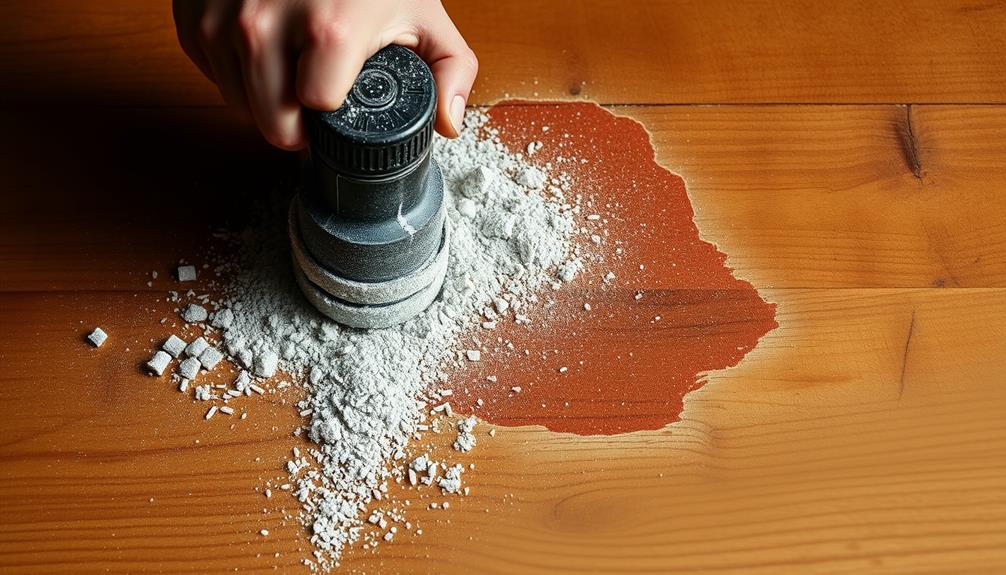
Sanding and prepping the surface is an essential step in refurbishing furniture that sets the stage for a flawless finish. Start by using coarse grit sandpaper (around 60-80 grit) to remove old paint and imperfections. Always sand with the grain of the wood to prevent scratches. For larger flat surfaces, a random orbital sander can save you time, while a sanding block or hand sanding is perfect for intricate areas.
Here's how to guarantee your surface is ready for the next step:
- Remove Old Finishes: Use coarse grit sandpaper to remove the entire surface's old paint and imperfections.
- Smooth the Surface: Progress to fine-grit sandpaper (120-220 grit) for a smooth finish.
- Clean Off Dust: After sanding, use a tack cloth to clean off the remaining dust and debris.
Make sure the wood is completely dry before you proceed to staining or sealing. This preparation is essential for achieving the best adhesion and quality of your wood finishes.
Taking the time to sand and prep properly will make a significant difference in your final result.
Applying Finishes and Sealants
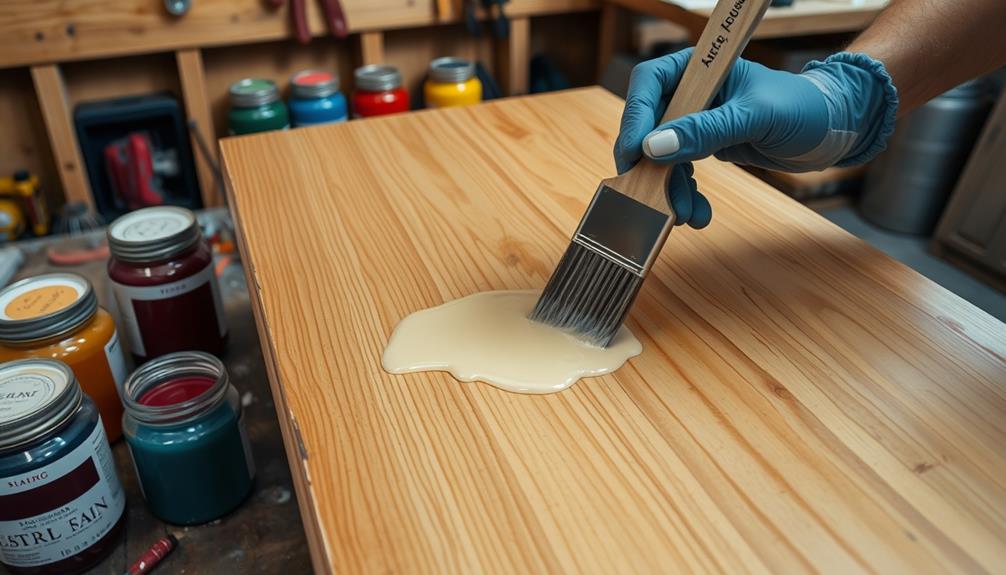
After you've thoroughly prepared the surface, it's time to apply finishes and sealants that will enhance the beauty and durability of your refurbished furniture.
Start by choosing between oil-based finishes, which provide a warm, rich look, or water-based options that offer quicker drying times and lower odors.
Before applying any stain or paint, don't forget to use a sanding sealant after sanding. This step prevents excess stain absorption and avoids unwanted color shifts, so make certain it dries completely.
When you're ready to stain, use a clean, lint-free rag or a paintbrush, wiping off excess within a few minutes to achieve a consistent color.
For sealing, apply polyurethane in multiple thin coats—typically 2-3—allowing 1-2 hours of drying time between each. Lightly sand between coats for a smooth finish.
Once the stain or paint has dried completely, consider using a topcoat varnish for additional protection against scratches and wear. This final touch will enhance the longevity of your finish, making sure your refurbished furniture stays beautiful for years to come.
Frequently Asked Questions
What Is the Best Way to Restore Old Furniture?
To restore old furniture, assess its condition, clean thoroughly, and repair any damages. Strip old finishes, sand the surface, then apply a quality sealant to protect and enhance the piece's natural beauty. You'll love the results!
How to Start Refurbishing Furniture for Beginners?
To start refurbishing furniture, choose a simple piece. Assess its condition, gather necessary tools, and follow a step-by-step process. Take your time, and don't rush; patience guarantees a better quality finish. If you’re new to this craft, it’s best to practice on projects that require minimal repairs before advancing to more detailed ones. As you gain confidence with refurbishing real-life pieces, you can also explore furniture placement in virtual spaces, such as learning **how to rotate furniture in Stardew** Valley to experiment with different layouts. Soon enough, both your hands-on and in-game design skills will improve significantly.
Is It Worth Restoring Old Furniture?
Absolutely, restoring old furniture's worth it! You'll enhance its value, preserve family history, and enjoy unique craftsmanship. Plus, it's often cheaper than buying new pieces, while promoting sustainability and reducing waste in your home.
Is It Cheaper to Refinish Furniture or Buy New?
Refinishing furniture typically costs between $50 to $300 per piece, making it often cheaper than buying new items that can exceed $2,000. You'll save money while personalizing your space and reducing waste.
Conclusion
Refurbishing furniture not only breathes new life into your pieces but also contributes to sustainability. Did you know that refinishing can save up to 90% of the resources needed to create new furniture? By taking the time to restore your old items, you're not just enhancing your space, but also making an eco-friendly choice. So grab your tools, get creative, and enjoy the rewarding process of transforming your furniture into something beautiful and unique! In addition to helping the environment, refurbishing furniture can significantly reduce the costs of updating your home. For instance, by repurposing an old vanity or cabinet, you can **save money on bathroom remodel** projects while still achieving a stylish, custom look. Not only will you be cutting expenses, but you’ll also have the satisfaction of knowing you’ve created a one-of-a-kind space.
